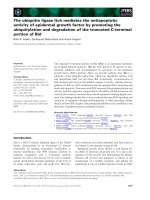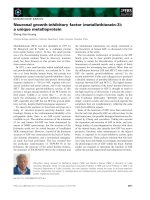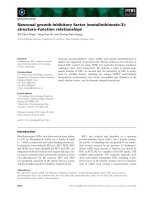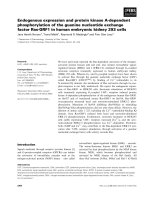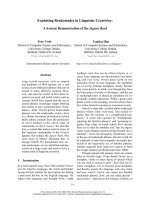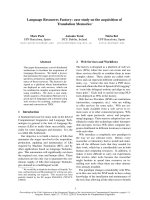Báo cáo khoa học: Epidermal growth factor receptor-regulated miR-125a-5p – a metastatic inhibitor of lung cancer potx
Bạn đang xem bản rút gọn của tài liệu. Xem và tải ngay bản đầy đủ của tài liệu tại đây (288.3 KB, 8 trang )
Epidermal growth factor receptor-regulated
miR-125a-5p – a metastatic inhibitor of lung cancer
Guofu Wang
1,2
, Weimin Mao
1
, Shu Zheng
2
and Jingjia Ye
2
1 Department of Respiratory Disease, Zhejiang Hospital, Hangzhou, China
2 College of Life Sciences, Zhejiang University, Hangzhou, China
Introduction
Lung cancer is the most frequent cause of cancer death
in the USA, with a mortality of approximately 85%
for all stages, according to population statistics [1].
Furthermore, it is the most common cancer both in
incidence rate and in death rate in developing coun-
tries such as China [2]. Clinical data have shown that
most lung cancer patients eventually suffer relapse
and ⁄ or metastasis after complete excision of the
cancer, even if they were at stage IA [3]. Despite the
progress that has been made in recent decades,
the mechanism of lung cancer development, including
relapse and metastasis, is not fully understood.
Growth factor signal transduction pathways play
key roles in various physiological and pathological
processes, encompassing metabolism, growth, prolifer-
ation, stress, development, and apoptosis. Abnormali-
ties in these signaling pathways lead to various
developmental disorders and diseases. In severe cases,
aberrant growth factor signaling may even give rise to
tumors. Among these pathways, epidermal growth
Keywords
epidermal growth factor receptor; lung
neoplasm; metastasis; microRNA; miR-125a
Correspondence
W. Mao, 12 Lingyin Road, Hangzhou
310013, China
Fax: +86 571 87995379
Tel: +86 571 87987373
E-mail:
S. Zheng, 88 Jiefang Road, Hangzhou
310006, China
Fax: +86 571 87214404
Tel: +86 571 87783868
E-mail:
Re-use of this article is permitted in
accordance with the Terms and Conditions
set out at ey.
com/authorresources/onlineopen.html
(Received 23 April 2009, revised 12 July
2009, accepted 27 July 2009)
doi:10.1111/j.1742-4658.2009.07238.x
Both the epidermal growth factor receptor signaling pathway and micro-
RNA (miRNA) play an important role in lung cancer development and
progression. To address the potential role of miRNA in epidermal growth
factor receptor signaling, we identified miR-125a-5p as a downstream
target, using an miRNA array. We further demonstrated that miR-125a-5p
inhibited migration and invasion of lung cancer cells. Moreover, miR-125a-
5p regulated the expression of several downstream genes of epidermal
growth factor receptor signaling. Importantly, examination of lung cancer
samples revealed a significant correlation of miR-125a-5p repression with
lung carcinogenesis. Taken together, our results provide compelling evi-
dence that miR-125a-5p, an epidermal growth factor-signaling-regulated
miRNA, may function as a metastatic suppressor.
Abbreviations
ECM, extracellular matrix; EGF, epidermal growth factor; EGRF, epidermal growth factor receptor; ERK, extracellular signal-related kinase;
FACS, fluorescence-activated cell sorting; miRNA, microRNA; MTT, 3-(4,5-dimethylthiazol-2-yl)-2,5-diphenyl-tetrazolium bromide.
FEBS Journal 276 (2009) 5571–5578 ª 2009 The Authors Journal compilation ª 2009 FEBS 5571
factor receptor (EGFR) signaling appears to be partic-
ularly important for epithelial malignancies, including
lung cancer [4]. However, despite the clinical impor-
tance, the underlying molecular mechanism by which
EGFR signaling regulates lung cancer development
remains poorly understood.
Recent studies have indicated that microRNAs
(miRNAs) are extensively involved in various signaling
pathways [5–7]. MicroRNAs are a class of small, non-
coding RNAs that play important roles in different
biological processes. Interestingly, since Calin et al.
first reported that miR-15 and miR-16 are deleted or
downregulated in the majority (approximately 68%) of
chronic lymphocytic leukemia cases [8], accumulating
evidence has implicated miRNA in human cancer [9].
Additionally, altered expression of miRNA has been
shown to mediate tumor metastasis [10,11]. However,
the relationship between miRNA and EGFR signaling
remains largely elusive.
Here, we set out to characterize the regulation of
miRNA expression by EGFR activation, using micro-
array analysis. We further determined that miR-125a-
5p could negatively regulate lung cancer cell migration
and invasion in vitro, and that this was frequently
decreased in lung cancer patients. Our data strongly
implicate miR-125a-5p as a potential inhibitor of
tumor metastasis.
Results
Repression of miR-125a-5p in response to EGFR
activation in lung cancer cells
It has been well established that EGFR signaling plays a
crucial role in lung tumorigenesis. Interestingly, accu-
mulating evidence has now implicated miRNA in the
formation and malignant progression of human cancer.
To examine the potential relationship between EGFR
signaling and miRNA, we first performed miRNA exp-
ression profiling after epidermal growth factor (EGF)
stimulation using the miRHuman_10.0_070802 miRNA
array, which contains 711 probes. Through comparison
of RNA prepared from a combination of three lung
cells, A549, PC9, and H1299, before or after EGF stim-
ulation, our profiling analysis revealed 39 miRNAs with
significantly different expression levels (P < 0.01;
Table 1). To further determine the requirement for
EGFR signaling in the expression of miRNA listed in
Table 1, we blocked EGFR signaling with gefitinib.
Gefitinib is an inhibitor of tyrosine kinase that competes
with ATP for binding to the intracellular kinase domain,
preventing receptor activation and the engagement of
downstream signaling transducers [12]. Thus, it has been
widely used to interfere with EGFR signaling. Consis-
tent with previous observations [13,14], PC9 cells, which
express a mutant EGFR and have been extensively
explored before, were more sensitive to gefitinib. Thus, a
low concentration of gefitinib could abolish the phos-
phorylation of EGFR, extracellular signal-related
kinase (ERK)1 ⁄ 2 and Akt after EGF stimulation. How-
ever, H1299 and A549 cells expressed wild-type EGFR,
and were less sensitive to gefitinib. Only a high concen-
tration of gefitinib could decrease the phosphorylation
of EGFR, ERK1 ⁄ 2, and Akt after EGF stimulation
(Fig. 1A). Accordingly, our miRNA array analysis
showed that, among the 39 miRNAs listed in Table 1,
Table 1. MicroRNA array analysis showed 39 miRNAs were in
response to EGF stimulation in lung cancer cells (P < 0.01).
Name Prestimulation Poststimulation Log ratio
miR-542-5p 51 228 3.19
miR-29b 169 506 1.57
miR-663 621 1125 1.16
let-7i 4494 8048 0.47
miR-25 5162 6490 0.43
miR-19b 909 1077 0.37
miR-29a 10 713 12 060 0.29
miR-15a 538 596 0.26
miR-24 9069 10 155 0.21
miR-17 6205 5218 )0.25
miR-106a 5990 4989 )0.28
miR-455-3p 303 263 )0.32
miR-151-5p 6483 5093 )0.34
miR-484 299 238 )0.35
miR-23a 21 099 17 298 )0.36
miR-181b 1309 1207 )0.41
miR-30d 1661 1203 )0.43
miR-26a 11 565 9160 )0.44
miR-361-5p 3379 2631 )0.44
miR-183 1536 1267 )0.51
miR-23b 21 710 15 380 )0.54
miR-15b 11 620 8384 )0.64
miR-130a 315 255 )0.64
miR-331-3p 272 164 )0.65
miR-99b 2920 1896 )0.69
let-7a 21 505 13 477 )0.80
miR-30c 5450 3314 )0.81
miR-224 2871 2090 )0.87
miR-30b 4382 2658 )0.92
let-7f 16 236 10 547 )0.94
miR-125a-5p 6882 3518 )1.03
let-7e 9822 5648 )1.06
let-7d 14 071 8423 )1.08
let-7c 13 905 7087 )1.21
miR-200c 7237 6774 )1.23
miR-574-5p 666 410 )1.28
miR-342-3p 394 174 )1.29
let-7b 7853 3379 )
1.48
miR-122 5148 254 )3.54
MiR-125a-5p inhibiting metastasis G. Wang et al.
5572 FEBS Journal 276 (2009) 5571–5578 ª 2009 The Authors Journal compilation ª 2009 FEBS
five miRNAs, inducing let-7i, miR-24, miR-25, miR-
29b, and miR-125a-5p, could be reversed by gefitinib
(Fig. 1B).
We further verified our array results by quantitative
PCR, which revealed the expression of miR-24, miR-25,
miR-29b and miR-125a-5p to be bona fide targets of
EGFR signaling (significantly regulated by EGF treat-
ment and reversed by gefitinib). Among these candi-
dates, miR-125a-5p appeared to be particularly
intriguing, because its level was altered most signifi-
cantly by EGF stimulation (Fig. 1C), and it has been
shown that miR-125a regulates the phosphorylation of
ERK1 ⁄ 2 and Akt in breast cancer cells [6].
MicroR-125a-5p negatively regulated cell
migration and invasion
EGFR signaling has been shown to play an important
role in cell migration and invasion [15]. Thus, the
marked repression of miR-125a-5p after EGFR activa-
tion prompted us to investigate whether miR-125a-5p
influenced tumor metastasis. We first performed Tran-
swell cell migration assays. PC9 cells were selected as a
model system with which to assess the function of miR-
125a-5p, because they expressed endogenous miR-125a-
5p at a relatively high level before EGF stimulation
(Fig. 1C). Our results showed that treatment with anti-
sense miR-125a-5p could significantly increase cell
motility (Fig. 2A). To examine their invasion capability,
cells transfected with antisense miR-125a-5p or negative
control were plated on top of a layer of extracellular
matrix (ECM) extracted from mouse sarcoma. Consis-
tent with the migration results, knockdown of miR125a-
5p significantly promoted invasion (Fig. 2A). To further
determine the function of miR125a-5p in cell migration,
we tested the polarized migration of cells by a wound-
healing assay. As shown in Fig. 2B, PC9 cells transfect-
ed with antisense miR125a-5p healed the scratch wound
much faster than the negative control. Representative
photographs of migration, invasion and wound-healing
are shown in Fig. 2C. Taken together, our data pointed
to an important role of miR-125a-5p in regulating cell
migration and invasion, suggesting that it might regu-
late the metastasis of lung cancer.
Inhibition of miR-125a-5p increased cell survival
and tube formation
In addition to regulating migration and invasion,
EGFR signaling also influences proliferation, angiogen-
esis, apoptosis, and cell cycle progression [15]. After
finding that miR-125a-5p negatively regulated cell
migration and invasion, we went on to determine
whether miR-125a-5p had an impact on cell prolifera-
tion, angiogenesis, apoptosis, and cell cycle progression.
We first examined its potential function in cell prolifera-
tion, which contributes heavily to tumor development.
A comparison with mock-transfected cells showed that
antisense miR-125a-5p significantly enhanced PC9 cell
growth (Fig. 3A).
A
B
C
PC9
01
pEGFR
pAkt
EGFR
Akt
β-actin
pERK1/2
ERK1/2
EGF(20 ng·mL
–1
) +
gefitinib (µmol·L
–1
)
010
A549 H1299
010
**
**
**
**
**
miR-25
miR-29b
miR-1
25a-5p
0
2000
4000
6000
8000
10 000
12 000
Serum-starved
EGF
Gefitinib + EGF
Signal value
let-7i
miR-24
0
2
4
6
8
10
12
PC9 A549 H1299
Serum-starved
EGF
Gefitinib + EGF
Relative level to EGF group
miR-125a-5p expression
Fig. 1. Gefitinib inhibited EGF-induced EGFR, ERK1 ⁄ 2 and Akt
phosphorylation and reversed EGF-stimulated miRNA expression in
lung cancer cells. (A) Western blot showed that, after EGF
(20 ngÆmL
)1
) stimulation, phosphorylation of EGFR, ERK1 ⁄ 2 and
Akt occurred in PC9, A549 and H1299 lung cancer cells, and that
this could be almost completely abolished by gefitinib at different
concentrations. (B) After EGF stimulation, miRNA microarray analy-
sis revealed that the expression of 39 miRNAs was significantly
altered (P < 0.01). Among these, five miRNAs, let-7i, miR-24, miR-
25, miR-29b, and miR-125a-5p, were further confirmed as EGFR-
regulated miRNAs by gefitinib treatment. **P < 0.01 as compared
with the serum-starved medium group. (C) Quantitative RT-PCR
showed that the mir-125a-5p level was significantly reduced after
EGF (20 ngÆmL
)1
) stimulation in all three cell lines, and that this
effect was reversed by gefitinib. The value for miR-125a-5p in the
EGF group was set at 1, and the relative amounts of miR-125a-5p
in the other groups were plotted as fold induction.
G. Wang et al. MiR-125a-5p inhibiting metastasis
FEBS Journal 276 (2009) 5571–5578 ª 2009 The Authors Journal compilation ª 2009 FEBS 5573
To answer the question of whether miR-125a-5p is
also involved in angiogenesis, we treated ECV304 cells,
showing significant expression of endogenous miR-
125a-5p (data not shown), with antisense miR-125a-5p.
After culture, angiogenesis was assessed with tube
formation assays. Consistent with its potential tumor-
suppressing role, we found that knockdown of
miR-125a-5p significantly enhanced the tube formation
efficiency of ECV304 cells (Fig. 3B,C).
Subsequently, we performed fluorescence-activated
cell sorting (FACS)-based cell cycle profiling and
apoptosis analysis. However, miR-125a-5p antisense
did not influence apoptosis or the cell cycle of PC9
cells (data not shown). Taken together, our results
demonstrated that miR-125a-5p played an inhibitory
role in lung cancer metastasis.
**
**
0
50
100
150
200
250
300
350
A
B
C
Migration Invasion
MiR-125a-5p antisense
Negative control
Cell number
**
**
*
*
**
0
20
40
60
80
100
120
0 h 6 h 12 h 24 h 36 h 48 h
MiR-125a-5p antisense
Negative control
*
*
**
Close width/scratched width (%)
Migration
Invasion
Negative control
Mir-125a-5p antisense
Wound healing
(48 h)
Fig. 2. Promotional effects of antisense miR-125a-5p on migra-
tion and invasion of PC9 cells. (A) Assay of migration and inva-
sion of antisense miR-125a-5p across 8 lm porous membranes
relative to negative control. (B) Confluent cell monolayers were
wounded with a pipette tip. Wound closure was monitored by
microscopy at the indicated times. Data are given as closed
width ⁄ scratched width (%). (C) Representative photomicro-
graphs of migration, invasion and wound-healing in PC9 cells
were taken with a Nikon ECLIPSETS 100 microscope.
**P < 0.001 and *P < 0.005, as compared with the negative
control. Magnification: for migration and invasion, ·200; for
wound-healing, ·100.
*
0
20
40
60
80
100
120
140
A
B
C
Negative control
30 nm antisense
Relative ratio to
negative control
30 nm antisense Negative control
**
Relative ratio to
negative control
0
20
40
60
80
100
120
140
160
180
Negative control 30 nm antisense
Length of tube
Fig. 3. Antisense miR-125a-5p facilitated the growth of PC9 cells
and tube formation of ECV304 cells. (A) PC9 cells (5 · 10
3
) cells
were plated on 96-well plates. Forty-eight hours later, MTT was
added to each well for 3 h at 37 °C, and then replaced by dim-
ethylsulfoxide. Absorbance was read at 570 nmolÆL
)1
. The data
are presented as percentage of growth relative to the negative
control. (B) ECV304 cells were cultured in a 12-well plate coated
with ECM gel. Photographs of tube formation were taken using
a Nikon ECLIPSETS 100 microscope (under ·200 magnification).
(C) Total tube length was measured with
IMAGE ANALYSIS software.
**P < 0.001, and P < 0.005, as compared with the negative
control.
MiR-125a-5p inhibiting metastasis G. Wang et al.
5574 FEBS Journal 276 (2009) 5571–5578 ª 2009 The Authors Journal compilation ª 2009 FEBS
Decreased miR-125a-5p expression in a subset of
human lung cancers
To gain further insights into the role of miR-125a-5p
in lung carcinogenesis and to examine the clinical rele-
vance of our findings, we investigated the expression
of miR-125a-5p in a panel of lung cancer patient
samples together with paired counterpart normal tis-
sues. With the criterion of a 2
)DDCt
value change of no
less than 2 between the malignant and normal groups,
we found that 33.33% (5 ⁄ 15) of lung cancer samples
showed significantly decreased expression of miR-125a-
5p by real-time RT-PCR. Thus, our results suggested
that downregulation of miR-125a-5p might contribute,
at least partially, to lung cancer development in human
patients.
Discussion
The EGFR signal transduction pathway regulates
essential cellular functions, and appears to play a cen-
tral role in the etiology and progression of numerous
epithelial malignancies, including lung cancer [4].
Moreover, the function of EGFR mutations in survival
of lung cancer patients and clinical respones to gefiti-
nib has been reported [16,17]. Thus, the identification
and characterization of potential factors that regulate
EGFR pathways are critical to our understanding of
lung cancer development and progression.
Emerging evidence has revealed the profound role of
various miRNAs in regulating cancer development. Dif-
ferent miRNAs have been implicated in the formation
of neoplasms, malignant progression, and metastasis.
To examine the potential miRNA targets of EGFR sig-
naling, we used the miRHuman_10.0_070802 miRNA
array, and identified miR-125a-5p as being regulated by
EGFR activation. To examine the cellular function of
miR-125a-5p, we employed comprehensive in vitro
approaches to establish the inhibitory role of miR-125a-
5p in cell proliferation, angiogenesis, cell motility, and
invasion. It is also of great interest and importance to
note that about one-third of the human lung cancer
samples that we examined revealed significant downre-
gulation of miR-125a-5p expression. Consistent with
our findings, miR-125a-5p has also been reported to be
downregulated in breast cancer biopsy specimens
[18,19]. Further investigations will be performed to
determine whether miR-125a-5p expression is clinically
correlated with lung cancer metastasis. Interestingly, the
present results, which showed miR-125a-5p negatively
regulating cancer cell metastasis, are consistent with our
previous work, which suggested that miR-125a-5p is
negatively correlated with lung cancer metastasis [11].
Together, the findings presented here strongly suggest
that miR-125a-5p may function as a tumor suppressor.
Except for let-7i, miR-24, miR-25, miR-29b, and
miR-125a-5p, our miRNA array analysis also indicated
another 42 miRNAs with significant differences by
comparing miRNA expression before and after gefiti-
nib treatment (P < 0.01; Table S2). Interestingly,
among them, some miRNAs, such as miR-16, miR-143,
miR-200b, and miR-205, were shown to be involved in
human cancer [8,20,21].
In view of our findings here and the results of Scott
et al. [6], showing that miR-125a blocked ERK1 ⁄ 2 and
Akt signaling in breast cancer cells, we will determine
whether miR-125a-5p regulates the phosphorylation of
Akt and ⁄ or ERK1 ⁄ 2 in lung cancer cells, and whether
miR-125a-5p downregulates ErbB2 and ErbB3 in lung
cancer cells, because the present work only focused on
the functional analysis of miR-125-a-5p.
In conclusion, we identified miR-125a-5p, an
EGFR-regulated miRNA, as a potential tumor meta-
stasis suppressor. Our results further substantiated the
role of miRNA in tumorigenesis, and revealed the pos-
sibility of using miRNAs as potential therapeutic
targets to specifically suppress oncogenic signaling
pathways that go awry in human cancers.
Experimental procedures
Cells and cultures
The human lung cancer cell line A549 was obtained from
the American Type Culture Collection (Manassas, VA,
USA) and maintained in Ham’s F12K medium (Invitrogen,
Carlsbad, CA,USA) supplemented with 10% fetal bovine
serum (Shanghai Sangon Biological Engineering Techno-
logy and Services Co., Ltd, Shanghai, China). The human
lung cancer cell lines H1299 and PC-9 were obtained from
Zhejiang Cancer Hospital and grown in RPMI-1640 med-
ium (Invitrogen) supplemented with 10% fetal bovine
serum. Human umbilical vein endothelial cells (ECV-304)
were obtained from the China Center for Type Culture
Collection (Wuhan, China), and cultured in RPMI-1640
medium supplemented with 10% fetal bovine serum.
Drugs and chemicals
Recombinant human EGF was purchased from Invitrogen.
Gefitinib (AstraZeneca, Macclesfield, UK) was a gift from
D. Chunfeng (Zhejiang Hospital, Hangzhou, China). A
250 mg gefitinib tablet was dissolved in 25 mL of dimethyl-
sulfoxide and stored at )20 °C. Antibody against EGFR
and antibody against phospho-EGFR were purchased from
Cell Signaling Technology (Beverly, MA, USA). Antibodies
G. Wang et al. MiR-125a-5p inhibiting metastasis
FEBS Journal 276 (2009) 5571–5578 ª 2009 The Authors Journal compilation ª 2009 FEBS 5575
against ERK1 ⁄ 2 and phospho-ERK1 ⁄ 2 were from Chem-
icon International, Inc. (CA, USA). Antibody against Akt
was from BioVision, Inc. (CA, USA), and antibody against
phospho-Akt was from Santa Cruz Biotechnology, Inc.
(Santa Cruz, CA, USA).
Western blot analysis
To examine the influence of gefitinib on phosphorylation of
proteins, confluent tumor cells were pretreated with gefiti-
nib at 0, 1, 2, 5 and 10 lm for 2 h before exposure to EGF
(20 ngÆmL
)1
) for 30 min at 37 °C. The cells were then
rinsed with ice-cold NaCl ⁄ P
i
, and lysed in chilled lysis buf-
fer comprising 10 mm Tris ⁄ HCl (pH 7.4), 1% NP-40, 0.1%
deoxycholic acid, 0.1% SDS, 150 mm NaCl, 1 mm EDTA,
and 1% Protease Inhibitor Cocktail (Sigma, CA, USA).
Protein concentrations were measured using the Bio-Rad
protein assay (Bio-Rad Laboratories, San Jose, CA, USA),
according to the manufacturer’s instructions. Then, 30 lg
portions of cell lysates were subjected to SDS ⁄ PAGE and
transferred to Immobilon membranes (Millipore, Bedford,
MA, USA). After transfer, the blots were incubated with
blocking solution, probed with various antibodies, and
washed. Proteins were detected using goat anti-(rabbit
IgG) (MultiSciences Biotech Co., Ltd, Hangzhou, China).
b-Actin (Anti-beta-Actin Monoclonal Antibody; Multi-
Sciences Biotech Co., Ltd, Hangzhou, China) was used as a
positive control.
RNA isolation and miRNA microarray
On the day after subculturing, cells were cultured under dif-
ferent conditions for 48 h: serum-starved medium, serum-
starved medium plus EGF (20 ngÆmL
)1
), and serum-starved
medium plus 1 lm (PC9) or 10 lm (A549 and H1299) gefiti-
nib plus EGF (20 ngÆmL
)1
). RNA was extracted with Trizol
reagent (Invitrogen) as the standard method. Separation,
quality control, labeling, hybridization and scanning of
small RNA were performed by LC Sciences (Houston, TX,
USA), using the miRHuman_10.0_070802 miRNA array
chip, based on Sanger miRBase Release 10.0. Preliminary
statistical analysis was performed by LC Sciences on raw
data normalized by the locally weighted scatterplot smooth-
ing (LOWESS) method on the background-subtracted data.
Then, in-depth data analysis was performed to identify
EGFR-regulated miRNA expression. MicroRNA with
P < 0.01 was considered as having a significant difference.
Real-time quantitative RT-PCR
Reverse transcription reactions were carried out using
dNTP, Moloney murine leukemia virus reverse transcrip-
tase and RiboLock ribonuclease inhibitor (Applied Bio-
systems, Foster City, CA, USA). Real-time PCR was
performed on an ABI PRISM 7300 Sequence Detection
System (Applied Biosystems), using an SYBR Green I
Real-Time PCR kit (GenePharma, Shanghai, China) for
miR-24, miR-25, miR-29b, and miR-125a-5p, and TaqMan
Universal PCR Master Mix, No AmpErase UNG (Applied
Biosystems) for let-7i; 5s and RUN6B (Applied Biosystems)
were used as positive controls. The relative expression levels
of miRNAs in each sample were calculated and quantified
by using the 2
)DDCt
method after normalization for expres-
sion of positive control. Primers for reverse transcription
and PCR are given in Table S1.
Cell migration and invasion assay
We performed the Transwell insert (24-well insert; pore
size, 8 lm; Corning, Inc., Corning, NY, USA) assay to
evaluate PC9 cell migration and invasion in vitro. In both
the migration assay and the invasion assay, an initial equi-
librium, obtained by adding 0.6 mL of RPMI-1640 with
10% fetal bovine serum to the multiple-well plate, was
employed to enhance cell attachment. For the invasion
assay, the inserts were coated with extracellular matrix gel
from Engelbreth–Holm–Swarm mouse sarcoma (Sigma,
Santa Clara, CA, USA). On the following day, 1 · 10
5
cells
suspended in 0.1 mL of fresh medium without fetal bovine
serum were added to the insert. Forty-eight hours after
seeding, the cells on the upper surface of the membrane
were removed using cotton buds. Cell monolayers on the
lower surface of the insert were fixed and stained using
standard cytological techniques. Six visual field of each
insert were randomly counted under a microscope (using
10 · 20 lenses).
Wound-healing experiment
Cells (1 · 010
6
) were seeded on six-well plates. Upon con-
fluence, the cell layer was scratched with a P-200 pipette tip
(Qiagen, Valencia, CA, USA) and then grown in normal
conditions after being washed with culture medium. Photo-
graphs of the wound adjacent to reference lines scraped on
the bottom of the plate were taken using a Nikon
ECLIPSE TS100 microscope (under ·100 magnification),
and the wound-healing was measured at 0, 6, 12, 24, 36
and 48 h, respectively. Sextuple assays were performed for
each experiment. Data were described as closed width ⁄
scratched width (%, mean ± standard deviation).
Tube formation assay
ECV304 cells (1 · 10
5
) were cultured in a 12-well plate
coated with 200 lL of ECM gel. Photographs of the tube
formation were taken using a Nikon ECLIPSETS 100
microscope (under ·200 magnification), and the length of
tube was quantified with image analysis software (devel-
MiR-125a-5p inhibiting metastasis G. Wang et al.
5576 FEBS Journal 276 (2009) 5571–5578 ª 2009 The Authors Journal compilation ª 2009 FEBS
oped at the US National Institutes of Health, and available
on the Internet at Each
experiment was repeated three times.
Cell proliferation assay
A Vybrant 3-(4,5-dimethylthiazol-2-yl)-2,5-diphenyl-tetrazo-
lium bromide (MTT) Cell Proliferation Assay Kit (Invitro-
gen) was used to estimate the effect of antisense miR-25a-5p
on the proliferation of PC9 cells. Cells were seeded at a
density of 5 · 10
3
cells per well in 96-well plates. After incu-
bation for 48 h, 20 lL of MTT solution (5 mgÆmL
)1
in
NaCl ⁄ P
i
) was added to each well for 3 h at 37 °C. Subse-
quently, culture medium with MTT was removed, and
formazan crystals were reabsorbed in 200 l L of dimethylsulf-
oxide (Shanghai Sangon Biological Engineering Technology
and Services Co., Ltd, Shanghai, China). Absorbance was
read at 570 nmolÆL
)1
using a Universal Microplate Spectro-
photometer (Bio-tek Instruments, Inc., Winooski, VT, USA).
Each experiment was performed in six replicate wells. Values
for control cells were considered as 100% viability.
Apoptosis analysis
PC9 cells were seeded in six-well plates (1 · 10
6
cells per
well). Seventy-two hours post-transfection, the cells were
harvested and stained with fluorescein isothiocyanate-conju-
gated antibody against annexin V and propidium iodide,
using the annexin V–fluorescein isothiocyanate apoptosis
detection kit (B. D. Biosciences Pharmingen, San Jose, CA,
USA). Stained cells were then quantified by FACSCalibur
flow cytometry (Becton Dickinson, Sandy, UT, USA).
Cell cycle detection
PC9 cells were plated in six-well plates (1 · 10
6
cells per
well). Seventy-two hours post-transfection, the adherent
cells and the supernatants were collected and centrifuged at
500 g for 10 min. Cell pellets were washed with NaCl ⁄ P
i
containing BSA (Invitrogen), fixed using 70% methanol,
and stored at )20 °C. The fixed cells were subsequently
washed twice with NaCl ⁄ P
i
and stained with PI and RNase
A (B. D. Biosciences Pharmingen), and DNA content was
analyzed by flow cytometry (Becton Dickinson).
Human lung cancer samples
Primary human lung cancers and paired noncancerous nor-
mal lung samples were obtained from 15 patients treated at
the Zhejiang Province Cancer Hospital, with documented
informed consent being obtained in each case. Samples
were frozen in liquid nitrogen and stored at )80 °C until
use. RNA extraction and quantitative RT-PCR were
performed as above.
Transfection
Cells were transfected with the Pre-miRTM miRNA Pre-
cursor of miR-125a-5p (Ambion, Inc., Austin, TX, USA)
and Anti-miR miRNA Inhibitors of miR-125a-5p (Ambion)
at 30 nmolÆL
)1
final concentration, using NeoFx (Ambion).
Efficiency of transfection was confirmed by real-time RT-
PCR. CyTM3-labeled Pre-miRTM Negative Control#1
(Ambion) and Anti-miR Negative Control#1 (Ambion)
were used as negative controls.
Statistical methods
Differences between groups were compared using Pearson’s
chi-square test for qualitative variables and Student’s t-test
for continuous variables. P < 0.05 was considered to be
significant.
Acknowledgements
This work was supported by National Basic Research
Program of China–973 Program (2004CB518707) and
Science Research 332 Fund, Ministry of Health of the
People’s Republic of China (WKJ2007-2-003) and
Health Bureau of Zhejiang Province (2009B009).
References
1 Jemal A, Siegel R, Ward E, Murray T, Xu J & Thun
MJ (2007) Cancer statistics 2007. CA Cancer J Clin 57,
43–66.
2 Zhang S, Chen W, Kong L, Li L, Lu F, Li G, Meng J
& Zhao P (2006) An analysis of cancer incidence and
mortality from 30 cancer registries in China, 1998–2002.
Bull Chin Cancer 5, 430–448.
3 Nesbitt JC, Putnam JB Jr, Walsh GL, Roth JA &
Mountain CF (1995) Survival in early-stage non-small
cell lung cancer. Ann Thorac Surg 60, 466–472.
4 Muller WJ, Sinn E, Pattengale PK, Wallace R & Leder
P (1988) Single-step induction of mammary adenocarci-
noma in transgenic mice bearing the activated
c-neu oncogene. Cell 54, 105–115.
5 Hermeking H (2007) p53 enters the microRNA world.
Cancer Cell 12, 414–418.
6 Scott GK, Goga A, Bhaumik D, Berger CE, Sullivan
CS & Benz CC (2007) Coordinate suppression of
ERBB2 and ERBB3 by enforced expression of
microRNA miR-125a or miR-125b. J Biol Chem 282,
1479–1486.
7 Yoo AS & Greenwald I (2005) LIN-12 ⁄ Notch activa-
tion leads to microRNA-mediated down-regulation of
Vav in C. elegans. Science 310, 1330–1333.
8 Calin GA, Dumitru CD, Shimizu M, Bichi R, Zupo S,
Noch E, Aldler H, Rattan S, Keating M, Rai K et al.
G. Wang et al. MiR-125a-5p inhibiting metastasis
FEBS Journal 276 (2009) 5571–5578 ª 2009 The Authors Journal compilation ª 2009 FEBS 5577
(2002) Frequent deletions and down-regulation of
micro-RNA genes miR15 and miR16 at 13q14 in
chronic lymphocytic leukemia. Proc Natl Acad Sci USA
99, 15524–15529.
9 Calin GA & Croce CM (2006) MicroRNA signatures in
human cancers. Nat Rev Cancer 6, 857–866.
10 Ma L, Teruya-Feldstein J & Weinberg RA (2007)
Tumor invasion and metastasis initiated by microRNA-
10b in breast cancer. Nature 449, 682–687.
11 Wang G, Mao W & Zheng S (2008) MicroRNA-183
regulates Ezrin expression in lung cancer cells. FEBS
Lett 582, 3663–3668.
12 Barker AJ, Gibson KH, Grundy W, Godfrey AA,
Barlow JJ, Healy MP, Woodburn JR, Ashton SE,
Curry BJ, Scarlett L et al. (2001) Studies leading to the
identification of ZD1839 (IRESSA): an orally active,
selective epidermal growth factor receptor tyrosine
kinase inhibitor targeted to the treatment of cancer.
Bioorg Med Chem Lett 11, 1911–1914.
13 Ono M, Hirata A, Kometani T, Miyagawa M, Ueda S,
Kinoshita H, Fujii T & Kuwano M (2004) Sensitivity to
gefitinib (Iressa, ZD1839) in non-small cell lung cancer
cell lines correlates with dependence on the epidermal
growth factor (EGF) receptor ⁄ extracellular signal-
regulated kinase 1 ⁄ 2 and EGF receptor ⁄ Akt pathway
for proliferation. Mol Cancer Ther 3, 465–472.
14 Amann J, Kalyankrishna S, Massion PP, Ohm JE,
Girard L, Shigematsu H, Peyton M, Juroske D, Huang
Y, Stuart Salmon J et al. (2005) Aberrant epidermal
growth factor receptor signaling and enhanced sensitiv-
ity to EGFR inhibitors in lung cancer. Cancer Res 65,
226–235.
15 Prenzel N, Fischer OM, Streit S, Hart S & Ullrich A
(2001) The epidermal growth factor receptor family as a
central element for cellular signal transduction and
diversification. Endocr Relat Cancer 8, 11–31.
16 Brabender J, Danenberg KD, Metzger R, Schneider
PM, Park J, Salonga D, Ho
¨
lscher AH & Danenberg PV
(2001) Epidermal growth factor receptor and HER2-
neu mRNA expression in non-small cell lung cancer is
correlated with survival. Clin Cancer Res 7, 1850–1855.
17 Ono M & Kuwano M (2006) Molecular mechanisms of
epidermal growth factor receptor (EGFR) activation
and response to gefitinib and other EGFR-targeting
drugs. Clin Cancer Res 12, 7242–7251.
18 Ioriol MV, Ferracin M, Liu CG, Veronese A, Spizzo R,
Sabbioni S, Magri E, Pedriali M, Fabbri M, Campiglio
M et al. (2005) MicroRNA gene expression
deregulation in human breast cancer. Cancer Res 65 ,
7065–7070.
19 Mattie MD, Benz CC, Bowers J, Sensinger K, Wong L,
Scott GK, Fedele V, Ginzinger D, Getts R & Haqq C
(2006) Optimized high-throughput microRNA expression
profiling provides novel biomarker assessment of clinical
prostate and breast cancer biopsies. Mol Cancer 5, 24,
doi:10.1186/1476-4598-5-24.
20 Michael MZ, O’Connor SM, van Holst Pellekaan NG,
Young GP & James RJ (2003) Reduced accumulation
of specific microRNAs in colorectal neoplasia. Mol
Cancer Res 1, 882–891.
21 Gregory PA, Bert AG, Paterson EL, Barry SC, Tsykin
A, Farshid G, Vadas MA, Khew-Goodall Y & Goodall
GJ (2008) The miR-200 family and miR-205 regulate
epithelial to mesenchymal transition by targeting ZEB1
and SIP1. Nat Cell Biol 10, 593–601.
Supporting information
The following supplementary material is available:
Table S1. Primers used in RT-PCR.
Table S2. Additional miRNAs responding to gefitinib
treatment in lung cancer cells (P < 0.01).
This supplementary material can be found in the
online article.
Please note: As a service to our authors and readers,
this journal provides supporting information supplied
by the authors. Such materials are peer-reviewed and
may be re-organized for online delivery, but are not
copy-edited or typeset. Technical support issues arising
from supporting information (other than missing files)
should be addressed to the authors.
MiR-125a-5p inhibiting metastasis G. Wang et al.
5578 FEBS Journal 276 (2009) 5571–5578 ª 2009 The Authors Journal compilation ª 2009 FEBS


